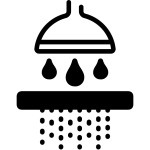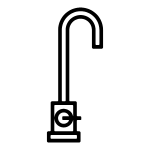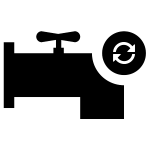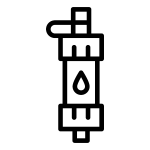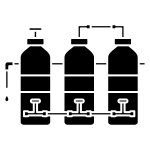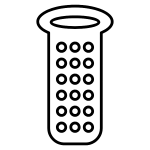Water is one of the most vital resources on Earth—and one of the easiest to waste. While many households focus on turning off lights or unplugging appliances to save energy, there’s one silent culprit draining your wallet and damaging the environment every day: a dripping faucet.
You might think, “It’s just a few drops.” But what if we told you that those few drops can add up to hundreds or even thousands of gallons of wasted water each year?
In this comprehensive guide, we’ll break down:
- Exactly how much water a dripping faucet wastes
- The environmental and financial impacts
- How to detect and fix a leak
- The best tools and solutions—like Cuoll water filters, water purifiers, and bathtub fixtures—to create a leak-proof home
Let’s dive in.
What Is a Dripping Faucet?
A dripping faucet is a tap that releases water in drops even when it is turned off. This typically results from worn-out washers, damaged valve seats, or faulty plumbing components. While the drip may appear small, it’s surprisingly wasteful when left unchecked over time.
How Much Water Does a Dripping Faucet Waste? The Numbers May Shock You
Let’s get into the math.
💧One Drip Per Second:
If your faucet drips once every second, that’s 86,400 drips per day. While the size of a drop varies slightly, the average is about 1/4 milliliter. That comes out to about:
- 5 gallons per day
- 150 gallons per month
- 1,825 gallons per year — from just one faucet!
🧯Five Faucets, Minimal Leaks:
If multiple faucets are leaking slightly across your home—like the kitchen sink, bathroom taps, and outdoor hose—the waste compounds dramatically.
A family with 5 leaky faucets could waste:
- 25 gallons per day
- 750 gallons per month
- 9,125 gallons per year
That’s enough to fill a small backyard swimming pool or take over 300 long showers.
Financial Impact: It’s Not Just Water You’re Losing
You’re not only wasting water—you’re wasting money too. According to the U.S. Environmental Protection Agency (EPA), household leaks can waste nearly 10,000 gallons of water each year, costing the average homeowner $150–$300 annually, depending on local water rates.
Plus, untreated leaks can lead to:
- Mold and mildew growth
- Higher energy bills (if hot water is leaking)
- Plumbing damage and costly repairs
- Water stains or deterioration in bathroom/kitchen areas
Environmental Impact: Wasting Water Harms the Planet
Wasting water doesn’t just affect your bills—it impacts the entire ecosystem.
Water processing involves:
- Energy consumption
- Chemical treatment
- Carbon emissions from pumping and heating
When you waste water, you’re indirectly increasing carbon emissions and depleting valuable resources.
Fun Fact:
It takes about 1.5 kilowatt-hours of electricity to pump and treat 1,000 gallons of water. That means the average leaky home indirectly consumes about 13.7 kWh extra every year—just due to faucet leaks.
How to Detect a Dripping Faucet
Sometimes a faucet is silently leaking or dripping into a hidden drain. Here’s how to spot trouble early:
1. Listen
Sometimes it’s an audible “drip” sound, especially at night.
2. Visual Inspection
Check the spout, joints, and handle for water accumulation.
3. Check Your Water Meter
Turn off all water in your house. If the meter is still moving, you may have a leak.
4. Use Food Coloring (Toilet Leaks)
Place a few drops in your toilet tank. If the color appears in the bowl without flushing, there’s a leak.
Common Causes of Faucet Drips
🛠️ Worn-Out Washer or O-Ring
The most common issue—over time, rubber components degrade and no longer create a tight seal.
🔩 Corroded Valve Seat
Water sediments build up and corrode the valve seat, preventing full closure.
🚿 Loose or Damaged Parts
Handles, nuts, and internal components may become loose or cracked.
💧 Water Pressure Issues
Excessive water pressure can cause slow leaks when the faucet is turned off.
How to Fix a Dripping Faucet
If you’re handy, you can repair most drips in under 30 minutes.
Tools You’ll Need:
- Adjustable wrench
- Screwdriver
- Replacement washer or cartridge
- Plumber’s tape
Basic Steps:
- Turn off the water supply
- Disassemble the faucet handle and components
- Inspect and replace washers or cartridges
- Reassemble and test
If you’re not confident, always consult a professional plumber.
Prevention Is Better Than Repair
Avoid dripping faucet issues altogether with preventive maintenance and upgrading your bathroom and kitchen fixtures.
💡 Tip: Choose high-quality products like those from Cuoll
At Cuoll, we provide durable, modern, and water-saving solutions for your entire home, including:
- Advanced water filters: Improve water quality and extend fixture life
- Eco-friendly water purifiers: Clean water without high pressure or buildup
- Leak-resistant faucets and showerheads
- Smart bathtubs and bathroom fittings designed for water conservation
Cuoll Product Spotlight: Solve Leaks the Smart Way
🚰 Cuoll Leak-Proof Faucet Collection
Our premium faucets feature ceramic disc technology that prevents drips and withstands years of use.
💦 Cuoll Water Filter Systems
Protect your entire plumbing system by eliminating hard minerals and sediment that corrode fixtures.
🛁 Cuoll Bathtubs with Integrated Flow Control
Perfectly designed for water-saving baths with temperature and pressure regulation.
How Cuoll Can Help You Save Water & Money
When you shop at Cuoll, you’re not just buying products—you’re investing in a smarter, more efficient, and eco-friendly lifestyle.
Here’s why homeowners trust Cuoll:
- ✅ Durable materials that resist corrosion and wear
- ✅ Water-saving designs that reduce waste
- ✅ Elegant, modern aesthetics to upgrade your bathroom or kitchen
- ✅ Excellent after-sales support and warranty
- ✅ Products compatible with both modern and traditional plumbing
Explore our water-saving collection today.
Additional Tips to Save Water Around the House
1. Install Aerators
Reduce faucet water flow by up to 50% without affecting performance.
2. Use Smart Water Monitors
Track your home’s water usage in real-time.
3. Insulate Pipes
Prevents pipes from freezing (and bursting), especially in colder climates.
4. Check for Silent Leaks Regularly
Even a small toilet leak can waste 200 gallons/day.
5. Turn Off Taps When Not in Use
Shaving, brushing, washing vegetables—don’t let water run unnecessarily.
Final Thoughts: Don’t Let Leaks Drain Your Wallet
So, how much water does a dripping faucet waste? A lot more than you think.
From environmental damage to financial loss, the cost of ignoring a leak is far greater than fixing it early. With Cuoll’s range of premium faucets, water filters, purifiers, and bathroom upgrades, you can ensure your home stays leak-free, efficient, and beautiful.
🌍💧 Let’s work together toward a water-smart future—one faucet at a time.
FAQs
❓How do I know if my faucet is leaking inside the walls?
A sudden increase in water bills, moldy smells, or wet patches on walls are clear signs. In this case, consult a plumber immediately.
❓Can a dripping faucet cause pipe damage?
Yes. Long-term leaks can cause rust, corrosion, and eventual pipe failure, especially in metal systems.
❓Are Cuoll faucets easy to install?
Absolutely. Most of our models include step-by-step installation guides and are compatible with standard fittings.


